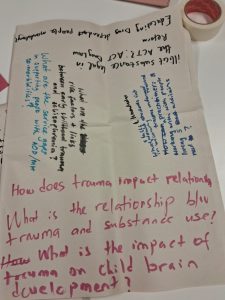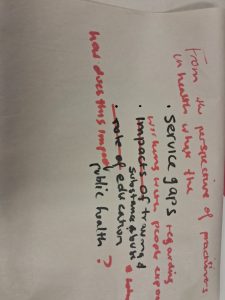4.4. Research and advocacy groups
![]() Use the links below to navigate the page.
Use the links below to navigate the page.
- Activity: Co-designed practitioner-research group: Contracting to start a participatory research project
- Activity: Co-designed lived experienced advocacy group: Contracting to start a campaign for positive social change
- Concluding comment and reflective questions
Internationally, co-designed participatory research networks, advocacy groups, and practitioner-academic research partnerships are popular (Pascoe et al., 2023; Russ et al., 2024). New ways of designing evidence-based social policies, research, and services are also emerging (Julkunen et al., 2024). Such networks, groups and partnerships recognise a need for opportunities and outcomes that create social change; they acknowledge the power of the case study, the importance of the narrative, and the voices of those with lived experience (Short et al., 2017; Regan & Lee, 1992). One example of a research group and an example of an advocacy group are presented here.
Activity: Co-designed practitioner-research group: Contracting to start a participatory research project
By Monica Short
Purpose: To create space for practitioners to begin to reflect on their practice critically. To identify a research question they could investigate together and potentially turn it into a research project.
Resources required: A basic understanding of the co-operative inquiry methodology. The following articles introduce this methodology. It is suggested that at least two of the following articles be read before the group:
- Russ, E., Petrakis, M., Whitaker, L., Fitzroy, R., & Short, M. (2024). Co-operative inquiry: Qualitative methodology transforming research ‘about’ to research ‘with’ people. Qualitative Research. https://doi.org/10.1177/14687941241234272
- Julkunen, I., Joubert, L., Fouché, C., Webber, M., Short, M., Whitaker, L., & Metteri, A. (2024). Practice research partnerships in social work: Addressing impact and credible evidence. Research on Social Work Practice, 34(6), 652-663. https://doi.org/10.1177/10497315241229680
- Short, M. (2018). The co-operative inquiry research method: A personal story. In M. Pawar, W. Bowles, & K. Bell (Eds.), Social work: Innovations and insights. (pp. 232-244). Australian Scholarly Publishing.
- Short, M., & Healy, J. (2017). Writing ‘with’ not ‘about’: Examples in co-operative inquiry. In S. Gair & A. V. Luyun (Eds.), Sharing qualitative research: Showing lived experience and community narratives. (pp. 188-203). Routledge.
Beginning phase: People take turns introducing themselves and sharing what they hope to gain from attending the research group. The social work facilitator provides an overview of the co-operative inquiry methodology and its four phases, which are summarised in Figure 2 below. They explain that this group focuses on the first phase of an inquiry, and people will work together to identify a common research question.
Figure 2:
A co-designed graphic representation of the four phases of co-operative inquiry based on Reason & Heron (1995); Jones-Mutton et al (2014) and Short & Healy (2017) from Pascoe et al (2023) reprinted with permission from INCInq.

Middle phase: The social work facilitator invites each group member to introduce themselves and outline what excites them about their work. Next, each group member takes turns to explain what they would like to share publicly about their work. This will take most of the group time.
Then, each group member writes a question or a theme on a shared butcher paper they would like the group to consider. Collectively, people start to identify a common work-related research question they could all work on.
End phase: When people come up with a question, they discuss whether they would like to have a follow-up meeting and how this group meeting would work. They also discuss whether they will need to apply for ethics approval for the project, whether they would like to keep the minutes of future meetings and whether these minutes could be used as data in the research project.
Activity: Co-designed lived experienced advocacy group: Contracting to start a campaign for positive social change
By Monica Short
This group is similar to the practitioner-research group; it follows the co-operative inquiry framework.
Purpose: People with lived experience critically reflect on a social issue and contract to begin a campaign for social change that encourages people to flourish.
Resources required: A basic understanding of the co-operative inquiry methodology. It is suggested that you visit the International Network of Co-operative Inquirers (INCInq) website before running this group.
- INCInq. (2024). What is a co-operative inquiry? https://incinq.csu.domains/what-is-cooperative-inquiry/
Beginning phase: People take turns introducing themselves and sharing what they hope to gain from attending the group. The social work facilitator provides an overview of the co-operative inquiry methodology and its four phases, which are summarised in Figure 2 above. The facilitator explains that the co-operative inquiry method will provide structure to their group meeting. They also explain that this group meeting focuses on the first phase of a co-operative inquiry. It will involve specifying the type of advocacy to be engaged and who will be involved in the social change campaign.
Middle phase: Each member of the group explains their experience of the issue. The facilitator asks the group members what they want to see change, why and what it will mean for people. Minutes are kept of the discussion.
Photograph 6 :
Brainstorming ideas for a co-design group. Photographs by Delphin Gil Jerly Gilbert


End phase: People review the co-operative inquiry process and discuss whether they would like a follow-up meeting and how this would work. They also discuss whether they would like to keep the meeting minutes and how they will be used. The next meeting’s agenda is drafted.
 Concluding comment and reflective questions
Concluding comment and reflective questions
Chapter 4 shared session plans for five therapeutic, three educational, three social, one research and one advocacy group. Every group is different, and two questions to consider when facilitating a group include:
- What is unique about each group member and this group?
- How can the session plans be tailored according to this uniqueness so everyone participating can flourish?
Reference list
Julkunen, I., Joubert, L., Fouché, C., Webber, M., Short, M., Whitaker, L., & Metteri, A. (2024). Practice research partnerships in social work: Addressing impact and credible evidence. Research on Social Work Practice, 34(6), 652-663. https://doi.org/10.1177/10497315241229680
Jones-Mutton, T., Jones, T., Short, M., & Bidgood, T. (2014). Field education: The social worker supervisors’ experience of off-site supervision for students in rural Australia [Poster presentation]. Joint world conference on social work, education and social development, Australia.
Pascoe, E., Short, M., Whitaker, L., Morris, B., Petrakis, M., Russ, E., Gersbach, K., Evans, S., Rose, J., Fitzroy, R., Reimer, L., Halton, C., Walters, C., & Berger, L. (2023). International Network of Co-operative Inquirers: Vision document. International Network of Co-operative Inquirers. https://researchoutput.csu.edu.au/en/publications/international-network-of-co-operative-inquirers-vision-document
Reason, P. & Heron, J. (1995). Co-operative inquiry. In R. Harre, J. Smith, L. Van Langenhove (Eds.), Rethinking methods in psychology (pp. 122-142). Sage.
Regan, S., & Lee, G. (1992). The interplay among social group work, community work and social action. Social Work with Groups, 15(1), 35-50.
Russ, E., Petrakis, M., Whitaker, L., Fitzroy, R., & Short, M. (2024). Co-operative inquiry: Qualitative methodology transforming research ‘about’ to research ‘with’ people. Qualitative Research. https://doi.org/10.1177/14687941241234272
Short, M., & Healy, J. (2017). Writing ‘with’ not ‘about’: Examples in co-operative inquiry. In S. Gair & A. V. Luyun (Eds.), Sharing qualitative research: Showing lived experience and community narratives. (pp. 188-203). Routledge.


